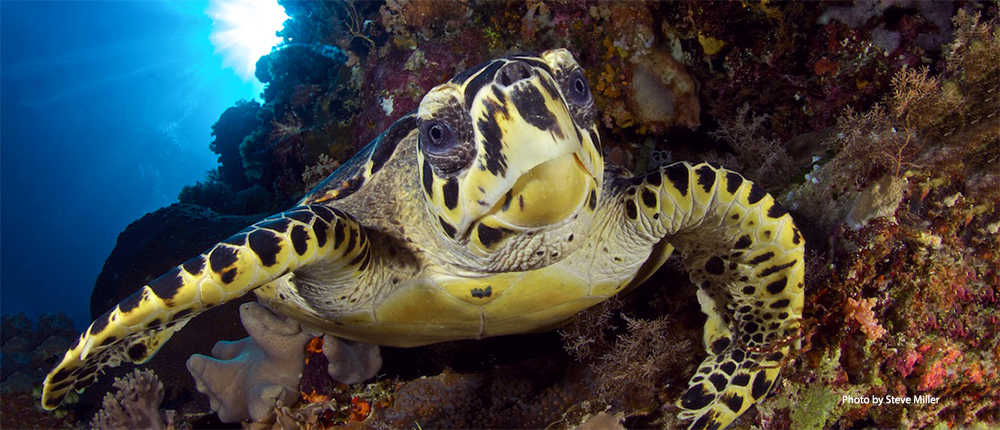Seeing Sea Turtles
Among the many fascinating sea creatures you are almost certain to see when diving or snorkeling the reefs around Wakatobi Dive Resort are sea turtles. You’ll spot the young ones moving about the inshore seagrass beds, run across gregarious adolescents munching on sponges on the reef, and possibly catch sight of a large adult napping under a ledge. Though you might not suspect it based on these predictable sightings, almost every species of sea turtle is listed as threatened or endangered throughout much of the world. The good news is that growing awareness of the plight of the turtles, along with programs such as Wakatobi’s Collaborative Reef Conservation Program, are giving these ancient mariners new hope for the future.
Which turtle?
Of the world’s seven known species of sea turtle, the two most often found in the waters around Wakatobi Resort are the green and the hawksbill. From a distance, you may not be able to tell one from the other, but when you get close enough to look them in the face, the differences are obvious.
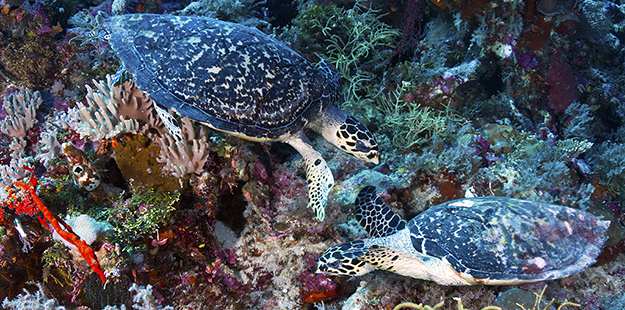
Unlike greens, which have a smoother edge to their shell, hawksbill turtles have a pair of serrated plates at their rear, making them easy to identify. Photo by Walt Stearns
True to its name, the hawksbill has a bird-like beak, while the green turtle has a blunt, bullet-shaped head. If you only catch the animal’s back end, and notice a pair of serrated plates bringing up the rear, it’s a hawksbill. The greens have a smoother trailing edge to their shells.
If you happen upon a large turtle, it’s almost certain to be a green. These animals can grow to lengths of five feet, and reach weights of more than 500 pounds. It takes them about a half century to reach that mark, and they can live to upwards of 100 years. Hawksbill, by comparison, grow to about half that size, and live about half as long.
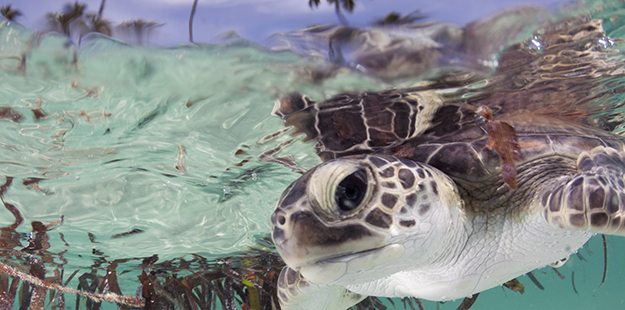
Green turtles start out as carnivores and switch to an exclusively vegetarian diet later in life. Photo by Steve Miller
Going green
Juvenile green turtles spend much of their time in shallow grass beds close to shore. They start out life as carnivores, feeding on small crustaceans and invertebrates, and chasing after jellyfish. Later in life, they switch to an exclusively vegetarian diet, and start munching on the sea grasses themselves. Green sea turtles play an important role in the health of the sea grass ecosystem. When turtles feed, they nibble on the upper parts of grasses without disturbing the plant’s roots. Think of them as a sort of biological lawnmower. All this grazing serves to improve the health and growth of the seagrass beds.
Green sea turtles play an important role in the health of the seagrass ecosystem. Think of them as a sort of biological lawnmower.
Green turtles get their name not from their salad-like diet or the color of their shells, but rather for the greenish tinge to their fat. Unfortunately for greens, they have long been prized by humans, for both their shells and their meat. In the Indo-Pacific, they were served as centerpieces of traditional ceremonial feasts. They were elevated to haute cuisine status in 18th century Europe, and were loaded aboard sailing ships, where they were kept alive in the holds until it was time for the stew pot. Fortunately, a growing number of countries now honor moratoriums on the harvesting and sale of wild turtle meat.
Our friend Larry Tackett came upon this green turtle while diving on Wakatobi’s House Reef.
Toxic treats
Hawksbill turtles enjoy a more varied diet that than their vegetarian cousins, and will dine on a mixed menu of sponges, anemones, algae, squid and shrimp. They often forage on coral reefs and poke around rock piles, using their narrow heads and beak-like jaws to reach into nooks and crannies. A hawksbill’s jaws are also perfectly shaped to rip and shred sponges, which are the turtle’s favorite food. Marine biologists have calculated that an adult hawksbill will eat more than a thousand pounds of sponges a year.
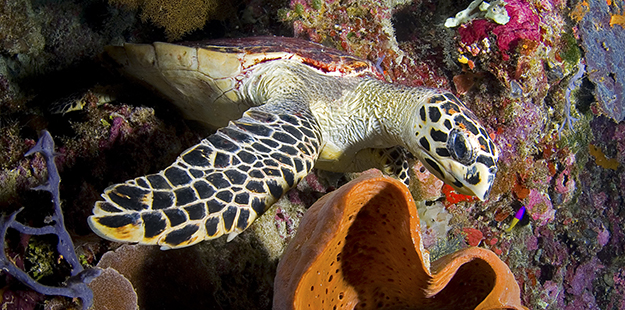
A hawksbill turtle’s jaws are shaped to rip and shred sponges, their favorite treat. Photo by Rodger Klein
For the most part, hawksbills are less likely to be harvested by humans for their meat. One reason for this is that a number of the sponges and invertebrates these turtles eat can be quite toxic. The hawksbill is able to absorb the toxins within its body fat without ill effect, but the meat can be poisonous to humans. This tends to discourage the harvesting of hawksbills, but every so often there’s a story about someone who got sick from eating one.
Getting up close
In Wakatobi waters, you are more likely to enjoy a close encounter with a hawksbill than a green, not only because they frequent the same sites as divers, but also because they tend to be more tolerant of humans, and easier to approach. That said, you always stand the best chance of getting close if you move in slowly and deliberately. If the turtle is feeding, you may be able to easy your way in for a portrait shot when it stops munching and raises its head. If the turtle is finning along the reef, you can often match speed and swim on a parallel course, approaching gradually from the side in a flanking maneuver.
What is never acceptable is making aggressive and intrusive moves that startle the animal and cause it to flee. When an otherwise well-meaning diver becomes over zealous in pursuit, it can stress and alter the animal’s behavior patterns. Turtles are actually air-breathing animals. By slowing their heart rate and body functions, they can stay underwater for as long as five hours. But when they have to expend extra energy–as when being pursued–they may have to surface in a matter of minutes.
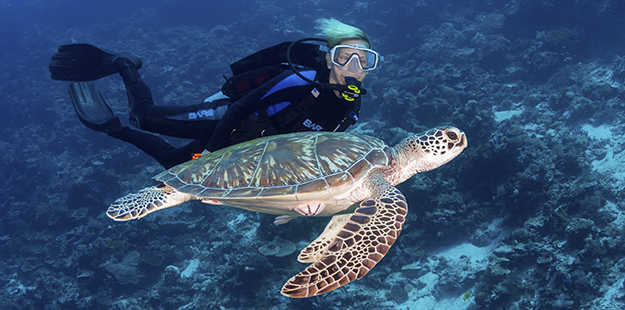
Divers can often follow turtles on a parallel course, matching their speed as they swim along the reef. Photo by Walt Stearns
While fewer sea turtles are eaten these days, they face a greater threat around the world due to a the degradation of reefs, the destruction of sea grass beds and loss of beach nesting habitats due to coastal development. One of the reasons for the relative abundance of sea turtles in the Wakatobi region is the protected status of the surrounding waters. The resort maintains a 20-kilometer stretch of reef as a no-take marine reserve. To encourage females to come ashore and build their nests on Wakatobi’s sandy beaches, the waterfront is not lit at night. And when a momma turtle does lay a clutch of eggs, the resort staff marks and monitors the site until the eggs hatch and the youngsters begin their short march to the sea.
So the next time you see a free-swimming sea turtle on a reef at Wakatobi Resort, go ahead and make a respectful and non-threatening approach to say hi. Just remember to treat these fascinating creatures with respect, and lend your support to programs that will help ensure the long-term health of these animals, not only at Wakatobi, but around the world.
Isn’t it time to experience Wakatobi’s marine life? Contact us at office@wakatobi.com or complete a quick trip inquiry at wakatobi.com.
Visit us on Facebook.
Great video footage @WakatobiYouTube


